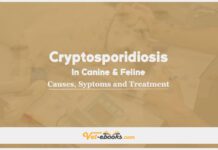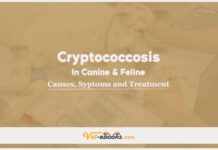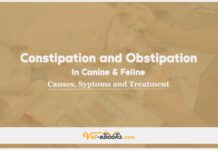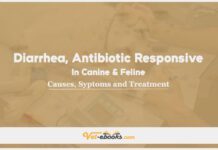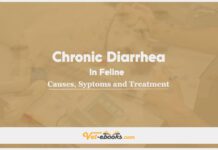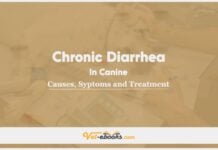Acute Diarrhea In Canine and Feline: Causes, Symptoms and Treatment
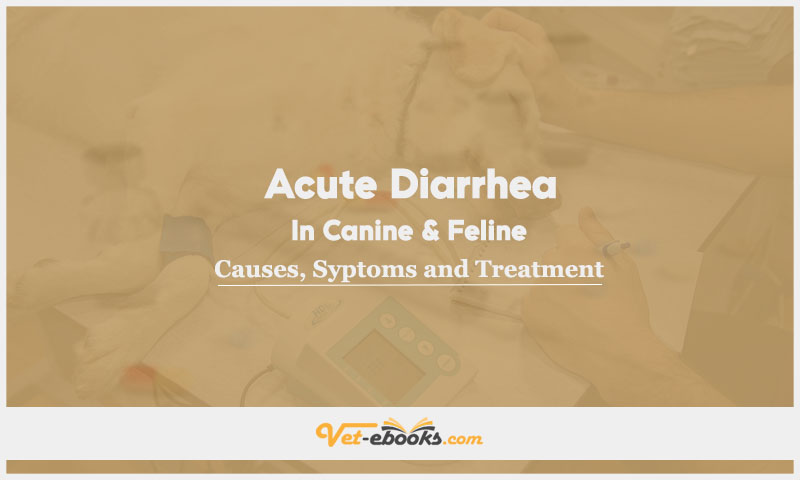
Contents
hide
Overview
Acute diarrhea is defined as diarrhea that lasts for less than seven days.
Causes of Acute Diarrhea In Canine and Feline
Causes
- Digestive System Disorders: Conditions such as hepatobiliary diseases, pancreatitis, and non-gastrointestinal neoplasia.
- Endocrine Disorders: Such as hypoadrenocorticism and hyperthyroidism.
- Infections: Bacterial enterotoxins, Salmonella spp., E. coli, and Campylobacter spp.
- Parasitic Infections: Several species of cestodes, hookworms, whipworms, and ascarids.
- Protozoal Infections: Such as giardiasis, tritrichomoniasis, and cercodiasis.
- Viral Infections: Including parvovirus, coronavirus, and canine distemper virus.
- Neorickettsia and Mycotoxins: Uncommon but potential causes.
- Acute Hemorrhagic Diarrhea Syndrome: A severe and often mysterious condition.
- Dietary Factors: Sudden dietary changes or inappropriate eating choices.
- Medications: Antibiotics, chemotherapeutic drugs, methimazole, poisons, and nonsteroidal anti-inflammatory medications (NSAIDs).
- Physical Obstructions: Such as mesenteric torsion, intussusception, and ingestion of foreign objects.
- Neoplastic Conditions: Primary neoplasia, including mast cell tumors, adenocarcinoma, leiomyoma/leiomyosarcoma, lymphoma, and metastatic lymphoma.
Risk factors
- An unplanned diet shift or dietary carelessness.
- Acute diarrhea can be a side effect of numerous drugs.
- geographic distribution effect.
Pathogenesis of Acute Diarrhea In Canine and Feline
The five primary causes causing excess water and/or solid content in feces are as follows:
- Osmotic: from poisoning, poorly absorbed substances, and maldigestion.
- Decreased absorption: mucosal damage brought on by chemicals, toxins, inflammation, or infection that results in the loss of absorptive cells.
- Increased secretion (secretory): regulated by inflammation, toxins, and parasympathetic activation.
- Increased permeability (exudative): substantial damage to the mucosa, lacteal membrane, and vessels as a result of ulceration, inflammation, or direct injury.
- Dysmotility: changes in motility have an impact on secretion, absorption, digestion, and hydration control.
Symptoms (History & Physical Examination) of Acute Diarrhea In Canine and Feline
History
- medication/toxin history, and general household practices.
- Use caution in identifying potential sources of infectious diarrhea and promptly isolating affected individuals.
- Different levels of activity can be observed, ranging from typical to sluggish.
- Small intestinal diarrhea is characterized by a large volume within the expected range, regular occurrence, and simultaneous weight loss and/or episodes of vomiting.
- Melena indicates a potential source of bleeding in the stomach or upper small intestine.
- Steatorrhea indicates the possibility of a maldigestive condition, such as exocrine pancreatic insufficiency (EPI).
- Large intestinal diarrhea is characterized by a small volume of stool, an elevated frequency of bowel movements, tenesmus, mucus in the stool, and passage of blood during defecation.
Physical Examination
- The condition of patients might range from stable to unstable.
- Dehydration, hypovolemia, stomach pain, nausea, and a gas during examination of the intestines
- During a rectal examination, there was melena, hematochezia, and steatorrhea.
Diagnosis of Acute Diarrhea In Canine and Feline
1- From History and Physical Examination
2- Diagnostic Procedures
CBC/BIOCHEMISTRY/URINALYSIS
- Hepatobiliary disorders with elevated hepatic enzyme activity.
- A rise in hepatic enzyme activity, hypoalbuminemia, and the presence of an inflammatory leukogram (signs of pancreatitis).
- Hypoalbuminemia and a reduced sodium-to-potassium ratio are observed in cases of hypoadrenocorticism.
- Parvoviral enteritis is associated with notable neutropenia.
- Hemoconcentration and prerenal azotemia occur as a consequence of diarrhea.
- Hypokalemia.
- Hypocholesterolemia.
- Hypoglycemia.
OTHER LABORATORY TESTS
- The baseline cortisol or adrenocorticotropic hormone (ACTH) stimulation test in canines.
- T4 levels in felines.
- Quantitative measurement of pancreatic lipase immunoreactivity.
- If there is a suspicion of exocrine pancreatic insufficiency (EPI), measure trypsin-like immunoreactivity.
- Urgent implementation of parvovirus ELISA.
- Fecal flotation, fecal direct smear cytology, and Giardia enzyme-linked immunosorbent assay (ELISA).
- Diarrhea PCR panel has shown potential for identifying specific pathogens, such as Salmonella.
Imaging:
Radiography:
- utilized to investigate non-gastrointestinal causes of diarrhea.
- Acute enteritis/enterocolitis is characterized by a minor occurrence of gas and/or fluid dilatation in the stomach and/or intestine.
- Pancreatitis is characterized by the widening of the gastroduodenal angle and the presence of localized reduced serosal detail at the proximal duodenal flexure.
Ultrasonography:
- To investigate the potential underlying causes of diarrhea, including both gastrointestinal and non-gastrointestinal factors, such as pancreatitis.
- An urgent ultrasonographic examination of the abdomen at the side of the cage is recommended for patients experiencing acute abdominal pain.
- To assess potential causes of the pain that require surgical intervention, such as septic or bile peritonitis.
- In cases where peritoneal effusion is observed, it is necessary to perform abdominocentesis and promptly conduct cytological analysis in a laboratory setting.
- Additionally, it may be appropriate to perform a culture test alongside the cytology analysis.
3- Differential Diagnosis
- It is improbable for acute diarrhea to be mistaken for other medical conditions.
- However, in rare cases, patients experiencing constipation may exhibit symptoms such as intestinal bleeding or the discharge of fluids, which can resemble the characteristics of severe diarrhea.
Treatment of Acute Diarrhea In Canine and Feline
General
- It is imperative to conduct a thorough evaluation of young patients, as they have the potential to exhibit instability even with subtle indications.
- Immediate implementation of isolation techniques is necessary for patients who may have an infectious cause of diarrhea.
- Fluid therapy is administered based on the patient’s hydration and perfusion state, as well as the continuous losses they may be experiencing.
- There may be a requirement for potassium supplements.
Medications
- Antidiarrheal medications such as loperamide, orally at a dose of 0.1mg/kg every 8-12 hours in dogs and 0.08mg/kg every 12 hours in cats.
- Anthelmintics such as fenbendazole at a dose of 50mg/kg PO q 24h for 5 days.
- Antiprotozoal drugs such as metronidazole at a dose of 10–20mg/kg PO q 12h for 5 days.
- Coccidiostatic drugs such as sulfadimethoxine and ponazuril.
- The administration of antibiotics is typically unneeded for the majority of cases involving moderate illness and may potentially worsen the symptoms of diarrhea.
- Probiotics can effectively reduce the duration of acute, nonspecific diarrhea.
Some Notes:
- The majority of instances of acute mild diarrhea resolve with minimal intervention, such as adhering to a low-fat diet and allowing for the passage of time.
- Nearly all pharmaceutical substances can cause side effects, such as vomiting and diarrhea, which frequently worsen the original condition.
- Cats may exhibit sensitivity to subsalicylates, and, as a result, it is advised to refrain from administering high or frequent doses to them.
- The prolonged utilization of metronidazole results in neurological problems.
- Certain animals exhibit sensitivity to medications containing sulfa, which are commonly used for the treatment of coccidia.
- Anticholinergic medications should be administered with caution or avoided altogether in patients who present with suspected intestinal obstruction, glaucoma, or intestinal ileus.
- Narcotic analgesics may induce central nervous system (CNS) depression, making them unsuitable for patients with more advanced illnesses who are already experiencing symptoms of sadness or lethargy.
- Narcotic analgesics should be used cautiously or avoided altogether in individuals with hepatic disease and bacterial or toxic enteritis.
- The primary approach to treatment in the majority of instances is fluid therapy and the repair of electrolyte abnormalities.
- The objective is to restore the patient to a state of adequate hydration within a period of 12 to 24 hours, while also replenishing any ongoing fluid losses.
- Acute diarrhea has the potential to lead to significant volume depletion, necessitating the implementation of intensive fluid therapy.
- The administration of potassium supplements is determined by the degree of severity, often measured by potassium chloride levels ranging from 20 to 40 mEq/L, in the majority of patients.
- It is important to note that potassium supplementation should not be administered during shock fluid therapy.
- The presence of hypokalemia has the potential to exacerbate the condition of ileus.
Tip
Do You Want To Increase Your Veterinary Knowledge and Practical Skills?
You Can Now Browse and Download +3000 Books For Veterinary Professionals & Students Online.
Download Veterinary Books

